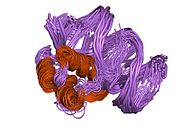Biology:PITX1
 Generic protein structure example |
Paired-like homeodomain 1 is a protein that in humans is encoded by the PITX1 gene.[1][2][3]
Function
This gene encodes a member of the RIEG/PITX homeobox family, which is in the bicoid class of homeodomain proteins. Members of this family are involved in organ development and left-right asymmetry. This protein acts as a transcriptional regulator involved in basal and hormone-regulated activity of prolactin.[3]
Clinical relevance
Mutations in this gene have been associated with autism,[4] club foot[5] and polydactyly[6] in humans.
Genetic basis of pathologies
Genomic rearrangements at the PITX1 locus are associated with Liebenberg syndrome.[7] In PITX1 Liebenberg is associated with a translocation or deletions, which cause insert promoter groups into the PITX1 locus.[7] A missense mutation within the PITX1 locus is associated with the development of autosomal dominant clubfoot.[5]
Interactions
PITX1 has been shown to interact with pituitary-specific positive transcription factor 1.[8]
References
- ↑ "Human and murine PTX1/Ptx1 gene maps to the region for Treacher Collins syndrome". Mammalian Genome 8 (11): 841–5. 1997. doi:10.1007/s003359900589. PMID 9337397.
- ↑ "Backfoot, a novel homeobox gene, maps to human chromosome 5 (BFT) and mouse chromosome 13 (Bft)". Genomics 40 (1): 108–13. February 1997. doi:10.1006/geno.1996.4558. PMID 9070926.
- ↑ 3.0 3.1 "Entrez Gene: PITX1 paired-like homeodomain transcription factor 1". https://www.ncbi.nlm.nih.gov/sites/entrez?Db=gene&Cmd=ShowDetailView&TermToSearch=5307.
- ↑ "Association of autism with polymorphisms in the paired-like homeodomain transcription factor 1 (PITX1) on chromosome 5q31: a candidate gene analysis". BMC Medical Genetics 8: 74. December 2007. doi:10.1186/1471-2350-8-74. PMID 18053270.
- ↑ 5.0 5.1 "Pitx1 haploinsufficiency causes clubfoot in humans and a clubfoot-like phenotype in mice". Human Molecular Genetics 20 (20): 3943–52. October 2011. doi:10.1093/hmg/ddr313. PMID 21775501.
- ↑ "Deletions in PITX1 cause a spectrum of lower-limb malformations including mirror-image polydactyly". European Journal of Human Genetics 20 (6): 705–8. June 2012. doi:10.1038/ejhg.2011.264. PMID 22258522.
- ↑ 7.0 7.1 "Homeotic arm-to-leg transformation associated with genomic rearrangements at the PITX1 locus". American Journal of Human Genetics 91 (4): 629–35. October 2012. doi:10.1016/j.ajhg.2012.08.014. PMID 23022097.
- ↑ "P-OTX: a PIT-1-interacting homeodomain factor expressed during anterior pituitary gland development". Proceedings of the National Academy of Sciences of the United States of America 93 (15): 7706–10. July 1996. doi:10.1073/pnas.93.15.7706. PMID 8755540. Bibcode: 1996PNAS...93.7706S.
Further reading
- "Backfoot is a novel homeobox gene expressed in the mesenchyme of developing hind limb". Developmental Dynamics 209 (2): 242–53. June 1997. doi:10.1002/(SICI)1097-0177(199706)209:2<242::AID-AJA10>3.0.CO;2-0. PMID 9186059.
- "NeuroD1/beta2 contributes to cell-specific transcription of the proopiomelanocortin gene". Molecular and Cellular Biology 17 (11): 6673–82. November 1997. doi:10.1128/mcb.17.11.6673. PMID 9343431.
- "Egr-1 is a downstream effector of GnRH and synergizes by direct interaction with Ptx1 and SF-1 to enhance luteinizing hormone beta gene transcription". Molecular and Cellular Biology 19 (4): 2567–76. April 1999. doi:10.1128/mcb.19.4.2567. PMID 10082522.
- "Ptx1 regulates SF-1 activity by an interaction that mimics the role of the ligand-binding domain". The EMBO Journal 18 (12): 3431–41. June 1999. doi:10.1093/emboj/18.12.3431. PMID 10369682.
- "Expression of the members of the Ptx family of transcription factors in human pituitary adenomas". The Journal of Clinical Endocrinology and Metabolism 84 (6): 2212–20. June 1999. doi:10.1210/jcem.84.6.5760. PMID 10372733.
- "Expression of pituitary homeo box 1 (Ptx1) in human non-neoplastic pituitaries and pituitary adenomas". Modern Pathology 13 (10): 1097–108. October 2000. doi:10.1038/modpathol.3880204. PMID 11048804.
- "Pitx factors are involved in basal and hormone-regulated activity of the human prolactin promoter". The Journal of Biological Chemistry 277 (46): 44408–16. November 2002. doi:10.1074/jbc.M207824200. PMID 12223489.
- "Modulation of interferon expression by hepatitis C virus NS5A protein and human homeodomain protein PTX1". Virology 306 (1): 51–9. February 2003. doi:10.1016/S0042-6822(02)00029-6. PMID 12620797.
- "Pituitary homeobox factor 1, a novel transcription factor in the adrenal regulating steroid 11beta-hydroxylase". Hormone and Metabolic Research 35 (5): 273–8. May 2003. doi:10.1055/s-2003-41301. PMID 12915995.
- "A genetic screen identifies PITX1 as a suppressor of RAS activity and tumorigenicity". Cell 121 (6): 849–58. June 2005. doi:10.1016/j.cell.2005.04.017. PMID 15960973.
- "Increased CDX2 and decreased PITX1 homeobox gene expression in Barrett's esophagus and Barrett's-associated adenocarcinoma". Surgery 138 (5): 924–31. November 2005. doi:10.1016/j.surg.2005.05.007. PMID 16291394.
- "Global, in vivo, and site-specific phosphorylation dynamics in signaling networks". Cell 127 (3): 635–48. November 2006. doi:10.1016/j.cell.2006.09.026. PMID 17081983.
- "New emerging role of pitx1 transcription factor in osteoarthritis pathogenesis". Clinical Orthopaedics and Related Research 462: 59–66. September 2007. doi:10.1097/BLO.0b013e3180d09d9c. PMID 17549029.
- "Identification of PITX1 as a TERT suppressor gene located on human chromosome 5". Molecular and Cellular Biology 31 (8): 1624–36. April 2011. doi:10.1128/MCB.00470-10. PMID 21300782.
External links
- PITX1+protein,+human at the US National Library of Medicine Medical Subject Headings (MeSH)
- http://omim.org/entry/602149 at OMIM, holds the most up to date information on PITX1.
- https://ghr.nlm.nih.gov/gene/PITX1 at the NIH, has a summary on the effects of PITX1 mutations.
This article incorporates text from the United States National Library of Medicine, which is in the public domain.
 |


